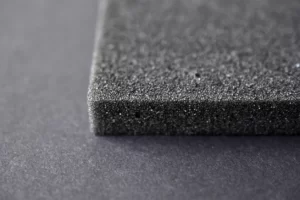Tensile strength is a parameter that measures the stress and strain of a material under tensile load, quantifying its strength. It is used in the development of materials requiring high strength, such as concrete and leather products, serving as an indicator for the stable production of high-quality products. In this article, we will explain tensile strength, yield point, test methods, and the tensile strength of various materials.
What is Tensile Strength
Tensile strength is one of the parameters that indicate the strength of a material. It describes the ability of a material to withstand tensile stress without failing.
Tensile strength is obtained by dividing the maximum tensile load by the cross-sectional area, expressed by the following equation:
TB=FB/A
{TB : Tensile strength (MPa), FB : Maximum tensile load(N), A: Cross-sectional area of the test specimen (mm²)}
Tensile strength is measured using an experimental method called a tensile test.
However, the strength of a material is not evaluated solely through this test; it is assessed comprehensively in combination with other mechanical strength properties.
Applications of Tensile Strength

The subjects of tensile strength measurement include metals, concrete, plastics, rubber, and fibers. There are mainly three purposes for measuring tensile strength of materials.
The first is for the development of new materials—knowing which current materials have the highest tensile strength can help develop materials that need to improve in that area.
The second reason is to ensure consistent quality during industrial production; a lot of components are used and they undergo several processes to turn raw materials into products. This leaves room for overmixing, introduction of cracks and micro-stresses, and the like.
Thirdly, it is for root cause analysis of defects and customer complaints. This is to ensure that these defects are avoided, to improve the quality assurance process, and be able to answer customers promptly.
Tensile Strength and Yield Point
During the measurement of tensile strength, as the tensile load is gradually increased, the material first undergoes elastically deformation, wherein the deformation is reversible, the material returning to original dimensions.
At a certain point, the material undergoes plastic deformation wherein the deformation is plastic, with the material not returning to its original dimensions. This certain point where the deformation becomes pronounced and permanent is called the “yield point.”
The yield point is frequently observed in carbon steels, such as iron and mild steel. The strain of the material under load before the yield point is continuous and reversible, but after the yield point, the material remains deformed and does not return to its original shape.
Methods for Testing Tensile Strength
There are multiple standard test methods for measuring tensile strength, the standard method used depends on the material.
For example, the test for measuring the tensile strength of woven fabrics is detailed in JIS L 1096 Method A (※1). Additionally, JIS Z 2241:2022 (※2) specifies the tensile test methods for metallic materials.
However, accurate values cannot be obtained unless the appropriate method is chosen for each material. Therefore, when planning a tensile test, it is important to consult with a specialized testing company.
※1 Reference: Japan Textile Products Quality and Technology Center, Tensile Strength Test (JIS L 1096)
※2 Reference: JIS Z 2241:2022
Tensile Strength of Various Materials
The following table shows the tensile strength of representative materials.
| Material | Tensile Strength (MPa) |
| Polyvinyl Chloride (PVC) (※3) | 41–52 (rigid) |
| Polyvinyl Chloride (PVC) (※3) | 11–25 (flexible) |
| Polystyrene (※3) | 36–52 |
| ABS Resin (※3) | 23–55 |
| Polyethylene (※3) | 23–31 (high density) |
| Polypropylene (※3) | 31–41(non-reinforced) |
| Brass | 100 |
| Stainless Steel | 350 |
| Steel塩化ビニル(※3) | 400–800(for automotive) |
※4 Reference: Japan Science and Technology Agency (JST), Hiroshima University, Creation of General-Purpose Plastic as Strong as Steel
Mechanical Strength Properties Measured Alongside Tensile Strength
When conducting a tensile test, various parameters related to strength can be obtained.
For example, these include the modulus of elasticity, proportional limit, fracture point, Poisson’s ratio, and the longitudinal modulus of elasticity (Young’s modulus).
The following table provides descriptions of each parameter.
| Parameter | Description |
| Modulus of Elasticity | A physical quantity indicating the extent to which strain responds elastically when a tensile load is applied. Specifically, it is the maximum load value at which the material returns to its original shape when the load is removed. |
| Proportional Limit | The maximum load value where the stress and strain are proportional under tensile load. Hooke’s Law, used to describe the stretching and compressing of springs, is applicable here. |
| Fracture Point | As tensile load continues to be applied, the stress eventually decreases and the material fractures. This point of fracture is called the fracture point, also called the point of failure, and the stress at this point is called the fracture stress. |
| Poisson’s Ratio | The ratio of the strain occurring in the longitudinal direction to the strain occurring in the lateral direction when a tensile load is applied. |
| Young’s Modulus | Also known as the longitudinal modulus of elasticity, it describes the relationship between stress and strain when a material is stretched in the longitudinal direction. Within a small strain range, the tensile load and strain have a proportional relationship, and Hooke’s Law applies. |
Conclusion
In this article, we explained the parameter for measuring material strength when a tensile load is applied, tensile strength. Tensile strength is obtained by dividing the maximum tensile load by the cross-sectional area.
Common applications include the development of products like metals, concrete, and fabrics, quality assurance, and root cause analysis of complaints. Tensile strength is standardized by detailed testing methods under organizations like JIS, tailored to different materials. It’s crucial to determine the appropriate testing method beforehand as each material has different standard methods that optimize how it is measured.
The “CrowdChem Data Platform” by CrowdChem Corporation provides insights and knowledge in the chemical field, including catalog information on products influencing tensile strength and associated patent information. Some resources are available for free, so feel free to explore and utilize them.









